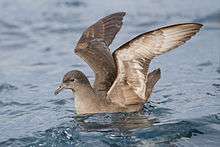Short-tailed shearwater
| Short-tailed shearwater, Slender-billed shearwater | |
|---|---|
 | |
| Scientific classification | |
| Kingdom: | Animalia |
| Phylum: | Chordata |
| Class: | Aves |
| Order: | Procellariiformes |
| Family: | Procellariidae |
| Genus: | Ardenna |
| Species: | A. tenuirostris |
| Binomial name | |
| Ardenna tenuirostris (Temminck, 1836) | |
The short-tailed shearwater or slender-billed shearwater (Ardenna tenuirostris; formerly Puffinus tenuirostris), also called yolla or moonbird, and commonly known as the muttonbird in Australia, is the most abundant seabird species in Australian waters, and is one of the few Australian native birds in which the chicks are commercially harvested. It is a migratory species that breeds mainly on small islands in Bass Strait and Tasmania and migrates to the Northern Hemisphere for the boreal summer.


This species appears to be related to the sooty shearwater and the great shearwater, which are also blunt-tailed, black-billed species, but its precise relationships are obscure (Austin, 1996; Austin et al., 2004). These are among the larger species of shearwater, which have been moved to a separate genus, Ardenna based on a phylogenetic analysis of mitochondrial DNA (Penhallurick & Wink, 2004).
Each parent feeds the single chick for 2–3 days and then leaves for up to three weeks in search of food. These foraging trips can cover a distance of 1,500 km (930 mi) and mean the chick may be left unattended for over a week. When the chicks fledge they weigh around 900 g (2 lb), and may be heavier than their parents. In Tasmania, and especially on the muttonbird islands of the Furneaux Group, the chicks are harvested at this time for food and oil. The largest population in the world (2.8 millions of pairs - about 12% of this species) seems to be located on Babel Island. Adult birds foraging for food on the open ocean mistake plastic debris for food and then feed it to their chicks.[2][3] This ingested plastic, as well as other factors, likely contribute to contamination of chicks.[4] Thousands of Short-tailed shearwater fledglings are attracted to artificial lights during their maiden flights from nests to the open ocean. Fledglings are vulnerable to injury or death by collisions with human infrastructure and once grounded, to predation or becoming road casualties.[5]
Each austral winter, the shearwaters migrate to the seas off the Aleutian Islands and Kamchatka. In the austral spring, they travel down the coast of California before crossing the Pacific back to Australia.
Culinary uses
Being a seabird, the flesh is covered in a considerable quantity of fat, which is normally removed in preparation of the meat before cooking.
When split down the breast and cooked on a barbecue, the resultant meat is red and thick, with a taste reminiscent of a beef steak more than of lamb, with a mild hint of the sea. The texture of the meat is similar to lamb or mutton and hence the name muttonbird.
References
- ↑ BirdLife International (2012). "Ardenna tenuirostris". IUCN Red List of Threatened Species. Version 2013.2. International Union for Conservation of Nature. Retrieved 26 November 2013.
- ↑ Carey MJ (2011) Intergenerational transfer of plastic debris by Short-tailed Shearwaters (Ardenna tenuirostris). Emu 111:229-234
- ↑ Ogi H (1990) Ingestion of plastic particles by Sooty and Short-tailed Shearwaters in the North Pacific. In: Shomura RS, Godfrey ML (eds) Proceedings of the Second International Conference on Marine Debris, 2–7 April 1989, Book NOAA-TM-NMFS-SWFSC-154_P635. U.S. Dept. of Commerce, Honolulu
- ↑ Lavers, J. L.; Bond, A. L. (2013-09-01). "Contaminants in indigenous harvests of apex predators: The Tasmanian Short-tailed Shearwater as a case study". Ecotoxicology and Environmental Safety. 95: 78–82. doi:10.1016/j.ecoenv.2013.05.021. PMID 23769126.
- ↑ Rodríguez, A; Burgan, G; Dann, P; Jessop, R; Negro, JJ; Chiaradia, A (2014). "Fatal Attraction of Short-Tailed Shearwaters to Artificial Lights". PLoS ONE. 9 (10): e110114. doi:10.1371/journal.pone.0110114.
- Austin, Jeremy J. (1996): Molecular Phylogenetics of Puffinus Shearwaters: Preliminary Evidence from Mitochondrial Cytochrome b Gene Sequences. Molecular Phylogenetics and Evolution 6(1): 77–88. doi:10.1006/mpev.1996.0060 (HTML abstract)
- Austin, Jeremy J.; Bretagnolle, Vincent; Pasquet, Eric (2004). "A global molecular phylogeny of the small Puffinus shearwaters and implications for systematics of the Little-Audubon's Shearwater complex". Auk. 121 (3): 847–864. doi:10.1642/0004-8038(2004)121[0847:AGMPOT]2.0.CO;2.
- Penhallurick, John; Wink, Michael (2004). "Analysis of the taxonomy and nomenclature of the Procellariformes based on complete nucleotide sequences of the mitochondrial cytochrome b gene". Emu. 104 (2): 125–147. doi:10.1071/MU01060.
Further reading
Identification
Gillson, Greg (2008) Field separation of Sooty and Short-tailed Shearwaters off the west coast of North America Birding 40(2):34-40
External links
| Wikimedia Commons has media related to Puffinus tenuirostris. |
- Short-tailed Shearwater Photos
- Parks & Wildlife Service Tasmania: Birds of Tasmania: Short-Tailed Shearwater, Puffinus tenuirostris
- Port Fairy website: Griffiths Island Shearwater Colony
- Annotated List of the Seabirds of the World - Shearwaters
